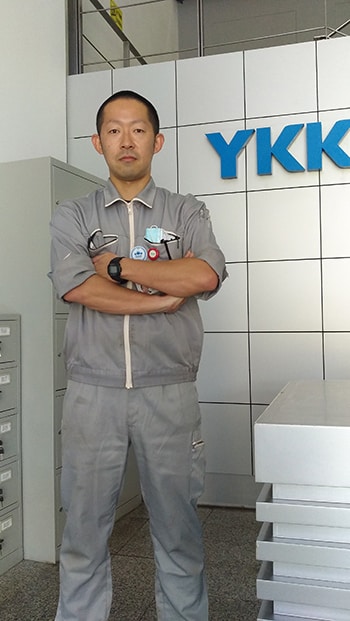 |
Hideyuki Mukai (As of the date of interview.) |
|---|
Environmental issues are becoming more diverse between different countries and regions. In China, the Environmental Protection Law and other laws and regulations were revised in 2015 to tighten environmental regulations. China's 13th Five-Year Plan, ending in 2020, sets targets for reducing the total emissions of major environmental pollutants, and companies are required to comply with them.
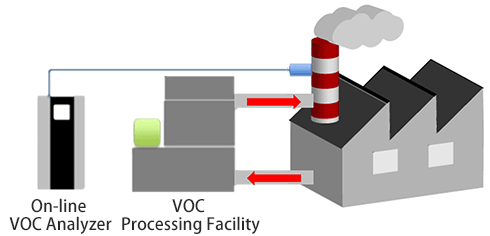
In particular, volatile organic compounds (VOC) are generated from solvents, paints, and petroleum used in manufacturing processes. VOCs cause chemical reactions in the atmosphere, creating chemicals which pose health risks to the human body. These include PM 2.5 particles and photochemical oxidants.
VOC reduction targets were set in China’s 13th Five-Year Plan, and laws have been established to strengthen emission regulations. After VOC reduction measures have been applied (activated carbon, combustion, catalysts, etc.), the emissions of companies subject to VOC regulations are constantly monitored with an on-line VOC Analyzer to ensure that they are within the regulated limits. This data is transmitted to local authorities and monitored in real time.
We interviewed Mr. Mukai, who is involved in environmental management at Shanghai YKK Zipper Co., Ltd, a member of the YKK Group, which is subject to emissions regulations in China.
Please tell us about China's environmental regulations and how your company introduced on-line VOC Analyzers.
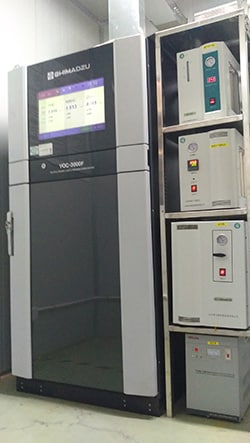
VOC Analyzer at the Min Xing Plant
In China, there is a so-called "Three-year action plan to win the battle to protect the blue sky", designed to keep the air clean. It emphasizes the management of volatile organic compounds (VOC) in targeted priority industries. Since our company's plants also emit VOCs, we have been instructed by the Chinese authorities to monitor their emissions using an on-line VOC monitor. On-line VOC Analyzers were installed at our Lin Gang Plant 4 years ago, and at our Min Xing Plant one and a half years ago, because these plants became subject to regulations as part of a major company emitting pollutants.
What is an On-line VOC Analyzer?
VOC stands for Volatile Organic Compounds. The WHO defines this as a generic term for organic compounds with a boiling point of 50-260 °C existing as gases in the atmosphere. Benzene, toluene, and xylene are typical substances contained in paints, adhesives, and detergents. These are considered to be a key cause of photochemical oxidants in the atmosphere.
Shimadzu's on-line VOC Analyzers use gas chromatographs equipped with FID detectors to constantly monitor the VOC components required by Chinese national standards. This instrument is manufactured and sold to comply with regulations in China.
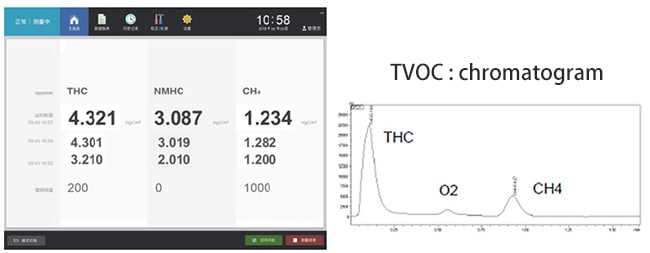
Display screen of the online VOC Analyzer
Shimadzu also uses its own mass spectrometers to quantify each component at the time of equipment delivery, and provides solutions that include verifying the appropriate data reliability and accuracy of on-line VOC Analyzers.
Please tell us about the benefits of installing Shimadzu's VOC Analyzers.
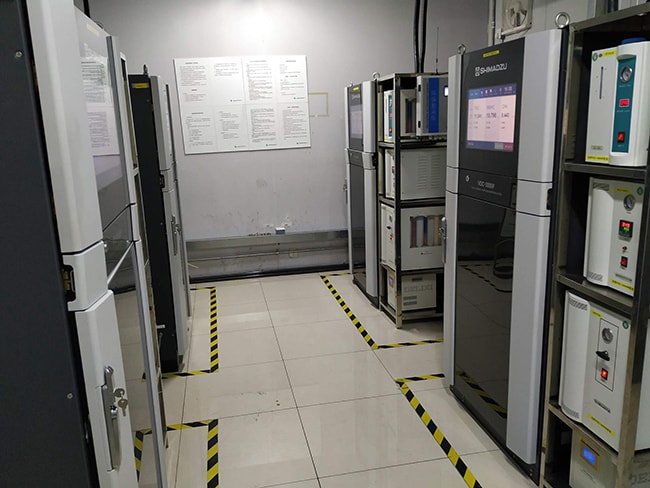
VOC Analyzers at the Lin Gang Plant
The goal was to quantify the amount of invisible VOC emissions in real time. In the past, we had asked an outside analysis contractor to conduct measurements four times a year and submitted reports to the Chinese authorities. But now we are constantly monitoring and reporting with an on-line VOC Analyzer. The ability to monitor emissions in real time helps to avoid risks such as having to suspend operations due to regulation violations.
The unexpected benefit was cost savings. The gases containing VOCs generated in the production process are treated with activated carbon before being emitted. The visualization of VOC emissions through an on-line VOC Analyzer means we can accurately time replacement of this activated carbon. We previously replaced the activated carbon twice a year, but this has been reduced to once a year, resulting in significant reductions in waste and costs. Another benefit is that less labor is required, since most of the monitoring work can be done automatically. In addition, during visitor factory tours and government inspections, they can view the VOC Analyzers, enabling them to understand our monitoring measures at a glance. In future, I would be grateful if the technical terms (component names, etc.) shown on the on-line VOC Analyzer could also be displayed in Chinese.
If you have any advice for other companies that are newly entering the Chinese market, please let me know.
It is important to recognize that the laws in Japan and China are completely different. In particular, we feel that environmental regulations here are stricter than those in Japan, and we also need to invest in environmental facilities. Regulations are frequently updated, and the authorities often point out violations. Regulatory values may change depending on the administration. As there are many points which are different from Japan, it is important to establish a system to grasp new information at all times.
What do you expect from Shimadzu in the future?
I use analytical instruments such as atomic absorption spectrophotometers on a daily basis. I would like you to consider a device for screening that is easy to use and to check on the spot. I feel that it is very important to carry out and understand analysis quantitatively, and I hope to see the development of instruments where the data can be analyzed easily on site.
At Shanghai YKK Zipper Co., Ltd., 2 plants use 9 VOC-3000Fs. At Shimadzu, we will continue to develop new products to comply smoothly with evolving environmental regulations. Thank you very much for your time today.
